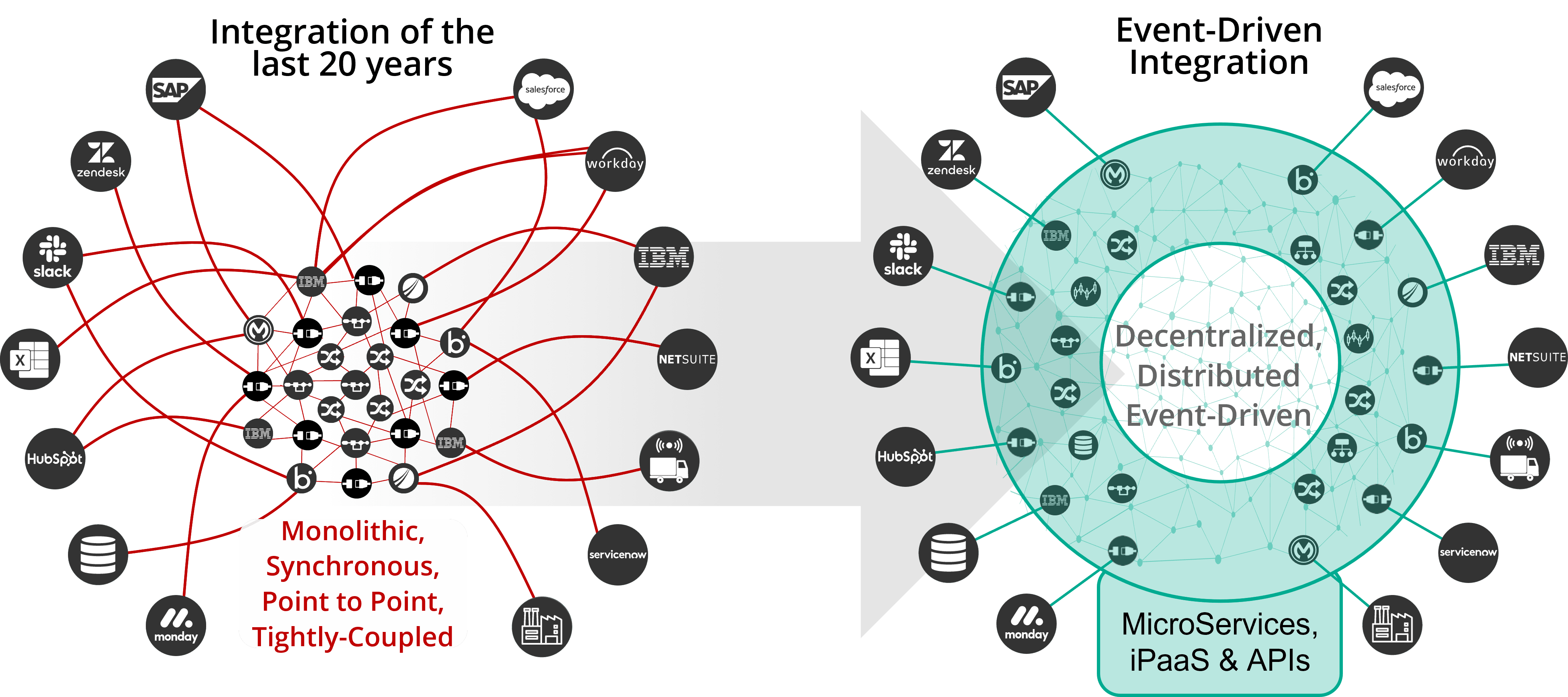Why Initiate BizTalk Migration Now?
- Migration Takes Time: Migration always takes longer than expected, so starting early on your BizTalk migration is a good idea. This gives you the opportunity to rethink your integration strategy, rather than simply lifting and shifting your current setup, and dealing with further issues down the road. What worked years ago probably isn’t the best solution now.
- End of Support: Microsoft BizTalk Server is scheduled to reach end of support in 2028. Continuing to rely on unsupported software poses security risks and lack of updates.
- Scalability Issues: It’s no secret that BizTalk Server struggles with scalability, especially in today’s dynamic and data-intensive environments.
- Complexity and Maintenance: With an end to support on the horizon, managing BizTalk Server deployments will become increasingly complex and resource-intensive, requiring specialized skills and frequent maintenance.
Why Event-Driven Integration?
Event-driven integration turns integration inside out by handling connectivity and transformations at the edge with micro-integrations, and real-time event-distribution via an event mesh at the core. Event-driven integration is an ideal way to approach BizTalk migration because it complements the RESTful API-centric integration approach most iPaaS’s take with asynchronous APIs that enable the real-time delivery of information when events occur across your enterprise.
Future-Proof your Integration Strategy as Part of Your BizTalk Migration
If you’re still using BizTalk, you’re likely thinking about how to plan for and improve your integration strategy so you don’t have to undergo another migration off of legacy tech anytime soon. Whether you plan to move to Azure Integration Services, SAP Cloud Integration, IBM Integration, or use an iPaaS, it’s important to consider how these solutions will fit into your overall architecture.
You may be planning to use integration technologies that already exist in your organization, but do they all connect together, in real-time, at scale? You may be using multiple clouds, multiple iPaaS, and point-to-point integration in some business units, creating silos and complexity in getting everything to work smoothly and efficiently. Now is the time to consider evolving your architecture with event-driven integration to connect all your integration technologies, AI, IoT, and more so you can actually get the benefits of your tech, not more headaches.
Relying on an iPaaS Alone for BizTalk Migration is not Enough
As your existing integration landscape gets more and more complex, depending solely on iPaaS for real-time integration isn’t enough. iPaaS has inherent limitations in latency, scalability, and flexibility, and since iPaaS operates on shared cloud infrastructure, it can introduce processing delays and resource bottlenecks, slowing down real-time performance. Scaling iPaaS solutions can also be challenging and expensive, often leading to performance issues under heavy loads. Plus, iPaaS can create integration silos and support only limited protocols, making it hard to seamlessly connect diverse modern technologies.
That’s where an event broker and event-driven integration come in. It complements iPaaS by offering immediate data processing, dynamic scalability, protocol agnosticism, and distributed processing, enhancing the overall system’s performance, resilience, and flexibility. By combining event-driven architecture with iPaaS, organizations can build a more robust and efficient real-time integration strategy that leverages the strengths of the event-driven integration pattern with a powerful service model.
Why Event-Driven Integration Should be at the Top of your List
So, you have a budget to migrate from BizTalk, a list of technologies you might use, and maybe a bit of FOMO watching competitors adopt the latest tech. Now’s the time to use this disruption to implement a BizTalk migration strategy that is modern, provides better results, and will survive the hype cycles of the future. So, let’s dive in a little more to some key reasons why event-driven integration should be making its way to the top of your wish list.
Event-driven integration is an enterprise architecture pattern built on leveraging the best capabilities of event brokers and integration platforms, and adopting an event-driven integration approach can ultimately save you time, money and more than a few headaches if implemented correctly. By combining the data transformation and connectivity of an iPaaS with the real-time dynamic choreography of an event broker and event mesh, enterprises can ensure their integrations are reliable and secure, and offer the flexibility to stay agile, so moving off of BizTalk is a breeze. You can:
- Improve the scalability, reliability and useful life of legacy applications and systems of record by enabling them to send and receive information in real-time.
- Accelerate innovation by making it easy to incorporate new apps, cloud services, IoT devices, and AI into existing business processes.
- Simplify the design of your growing system by replacing point-to-point integration that relies on synchronous communications with more flexible asynchronous and one-to-many interactions.
By taking an event-driven integration approach to your BizTalk migration, you’ll be able to take advantage of real-time data processing and have greater flexibility than what an iPaaS alone offers. Event-driven architecture allows for immediate responses to business events, reducing latency and improving operational efficiency. It scales effortlessly with demand, handling varying loads without significant upfront investments. And, it seamlessly integrates with modern technologies like iPaaS, IoT and AI, fostering innovation and agility in a rapidly evolving market. This proactive, real-time approach to data integration complements your existing technology so you don’t have to rip and replace. Instead, it strengthens your existing and new integration tools and aligns better with contemporary business needs, providing better performance. And, you won’t have to rewrite interfaces from scratch.
Why Solace for BizTalk Migration?
Businesses run Better with Solace
When it comes to event-driven integration, Solace is a leader. Solace has a proven track record helping businesses of all sizes and industries become more agile, efficient and real-time. Integrating seamlessly with legacy and modern tech, Solace provides the real-time digital foundation of the future.
Solace PubSub+ Platform allows you to build an event-driven integration infrastructure that works with all systems, from legacy monoliths to cloud-native SaaS and iPaaS solutions. It offers a robust, scalable, and secure platform for businesses looking to make their transition from BizTalk a success.
You’ll benefit by embracing event-driven integration with PubSub+ Platform in three ways:
- Reduce costs with efficient data movement – One of the most compelling reasons to migrate from BizTalk is the financial benefit. As BizTalk moves past mainstream support, maintaining this legacy system will become increasingly expensive due to rising direct support costs and the operational overheads associated with aging hardware and outdated software architectures. Solace’s efficient data movement and event mesh technology reduce these costs by optimizing resource usage and minimizing the need for costly infrastructure investments.
- Increase agility with cloud – The agility offered by cloud-native integration solutions is unmatched, especially when it comes to scaling operations to meet business demands. Solace offers unparalleled agility through its event mesh technology, which enables seamless real-time data distribution across hybrid and multi-cloud environments. This flexibility allows businesses to quickly scale operations to meet changing demands without significant upfront investments. Solace’s platform is designed to integrate smoothly with modern technologies like iPaaS, AI and machine learning, providing a competitive edge through smarter, data-driven decision-making and the automation of complex processes.
- Improve security and compliance– You can’t afford to be left behind when it comes to securing your business and ensuring compliance with your own policies and industry regulations. Solace includes built-in security features and compliance controls that meet stringent industry standards, ensuring data integrity and protection. This proactive security approach relieves businesses of the burdens associated with achieving and maintaining compliance, allowing them to focus on growth rather than navigating data security regulations.
Solution Advantages
Solace provides the number one event-driven integration and streaming platform – an ideal digital backbone to link your integration technologies. It integrates seamlessly with all major iPaaS vendors (Microsoft Azure Integration Services, Boomi, Mulesoft, SAP, SnapLogic, etc.), and micro-integrations make it easy to develop event-driven integrations. Solace is superior in the following ways:
- Plug-and-Play
Rich micro-integrations for leading iPaaS offerings make it easy to connect the variety of integration tools and technologies you use across lines of business and use cases, and they’re all built and managed by Solace. - Rich connectivity options
Support for your favorite protocols and APIs lets you connect to and translate data from legacy apps, IoT devices, and cloud services using their language of choice. - Event Mesh
An event mesh (interconnected network of event brokers) lets you quickly, dynamically, and securely distribute data across your enterprise and around the world no matter what – even in the face of network failures, natural disasters and application issues. - Buffer for Bursts
Event brokers can temporarily store messages to a queue or topic until your iPaaS is ready to process them, or downstream applications are able to receive them, so they aren’t overwhelmed by sudden spikes in traffic or application outages. - Easy Management
Unique event portal software that makes it easy to collaboratively create and manage the events and event flows that enable real-time, event-driven interactions between systems and self-service access to events with appropriate governance.
Conclusion: Event-Driven Integration Can Accelerate and Simplify Your BizTalk Migration
Start planning your BizTalk migration now to gain the benefits of modern integration technologies and hybrid cloud sooner. Explore your options and discover how Solace can enhance your migration from BizTalk, optimizing your integration infrastructure for future growth with the power of real-time connectivity.
Event Driven Integration with iPaaS: The Power of Real-time ConnectivityIn this white paper, Jesse Menning describes the benefits of using an iPaaS solution, the challenges you can face with handling real-time data, and how event-driven integration can solve some of these challenges.Download

Anna is a senior product marketing manager at Solace, with over 15 years of experience in enterprise software, driving product adoption and market penetration for integration and API management products. She loves crafting messaging and compelling narratives that build brand authority. With a passion for innovation, Anna enjoys collaborating with cross-functional teams to successfully launch campaigns that enhance product visibility and drive revenue growth – all while helping organizations navigate the complexities of digital transformation.

